Eric Fischl - Per Contra Interviews
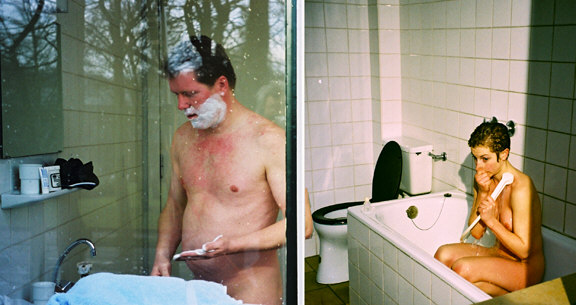
Photoshop Sketch for Bathroom Scene 2, Krefeld Project
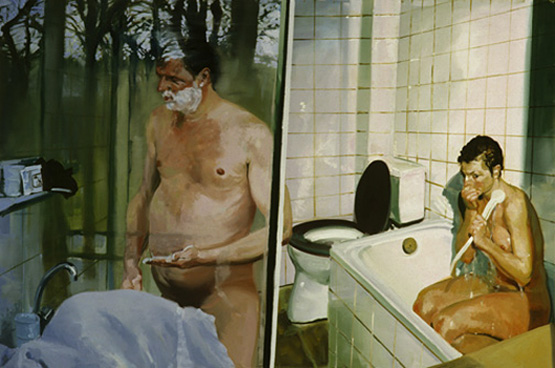
Krefeld Project, Bathroom
Scene 2
2003
Oil on linen
72" x 108"

Turning, Photoshop Sketch
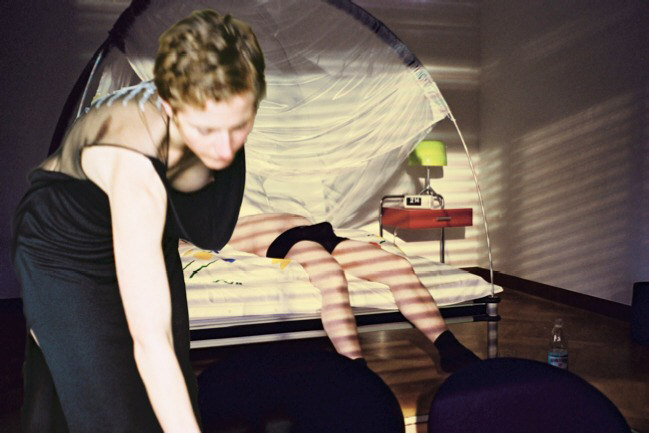
Reaching to Turn Off What? Photoshop Sketch
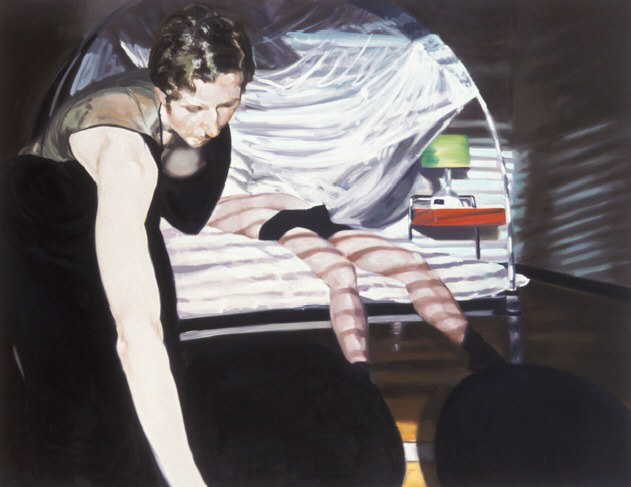
Bedroom Scene #3, Mistakes Mistakes! Everthing Shakes From all the Mistakes
2004
Oil on linen
87” x 113”
For a more complete selection of Eric Fischl's work, go to Eric Fischl's Website.
PC: Have you had the experience of looking at something you painted a decade or so ago, and finding yourself surprised, with a new “reading”?
EF: Not really.
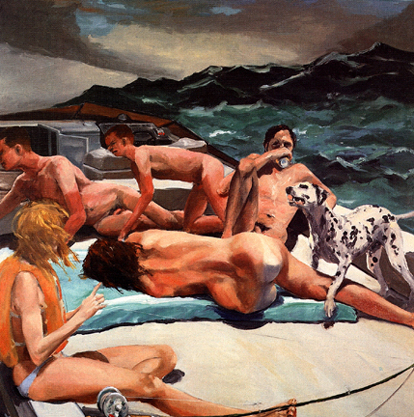
The Old Man's Boat, the Old Man's Dog
1982
Oil on linen
84" X 84"
PC: Some painters (and writers) hate giving their work titles. Some of your titles direct the audience’s attention to one of the figures, provide a point of view. Others are quite neutral. Do some of the titles come more easily to you than another? Do you try out a number of titles before selecting the one you end with? You’ve shared the genesis of some works with the world (The Brat and Bad Boy). Do you remember any similar progressions with titles? Is it a brainstorming?
EF: I have almost entirely lost the ability to title works. It drives me crazy. They all feel added on. Most of them I can’t even remember, which is really a terrible thing to say.
PC: When you do a series/cycle of paintings (e.g., The Bed, The Chair...) do you have a particular order you want them to be seen? In The Romance of Travel, you do...but what about the Krefeld Project?
EF: The Travel of Romance has a particular and necessary order to it and that is why I titled each on a scene and number. The Krefeld Project is not a sequence but rather a context. It is the context of a house and the ideal viewing would have been to see it in situ at that house in Krefeld.
PC: When I look at The Brat, I like thinking about the scenes you painted over to get there—the wedding, the raucous wedding party—and looking for the emotional left-overs in what I see going on. You’ve also talked about the genesis of Bad Boy, the bowl of fruit, the baby (who was painted out), the small boy (who was painted out, but who became the youth whose back is to us in the painting). What do you think about genetic criticism, looking at the changes the artist made, as a way of understanding paintings (or literature)?
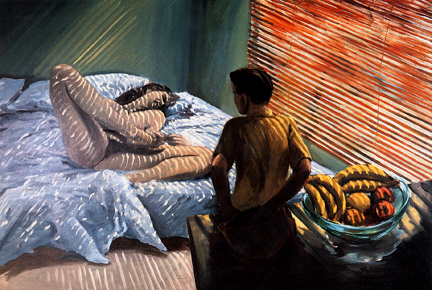
Bad Boy
1981
Oil on Linen
66" X 96
EF: Modernism has always had this obsessive fascination with process. I used to be more intent on bringing the viewer into the creative process by encouraging them to deconstruct the pictures. That is where the glassine drawings and later the multiple panel paintings came from. But ultimately I think not. I would rather experience the magic trick than be shown how it was achieved. In many of my paintings, especially the earlier ones, there is the route I took to get to the finished piece but it is a route full of dead ends and senseless meanderings.
PC: Does the computer as a tool make your work easier? What proportion of your work is done using Photoshop and collaging compared with studies on paper? Do you save your computer work on disks or keep notebooks? Or do you prefer the direct relationship between the audience and the painting?
EF: Until I learned how to use Photoshop my paintings were constructed pretty much directly on the canvas using photo references that I would collage together. Being schooled by second generation Ab-Ex painters who instilled in me the ethos that discovery and execution should happen solely on the canvas, I was reluctant to work in Photoshop. Photoshop separated the discovery from the execution and my initial fear was that it would deaden the painting. What I found was that it freed me to explore painting in a way I hadn’t done before.
PC: You have many paintings in which dogs appear: Dalmatians, Labs, the Collie and other dogs in Woman Possessed (breed or mutt?), the little dog wearing the party hat in Dog. So, do different breeds have specific connotations for you, or is the choice purely visual? And if they have different associations, would you please share them with our readers?
EF: As for dogs, I often joke that a painting without a dog is no painting at all. Perhaps I am only half joking because for me the dog works as a different kind of consciousness within the narrative moment. It is that animal “otherness” which is effected by the emotional drama of the moment without judging it or anticipating its consequences. The dog is love or rather loving and in that canine pathos of unconditional love my dogs hold strong as if strapped to their mast(er) tossed about in the emotional maelstroms of human need. I choose different breeds for their differing characteristics; Dalmatians because they chase fire, labs because they are so cuddly and benign, Italian greyhounds because they are so twitchy nervous, etc. The dogs I choose for particular scenes work as foils or mirrors or counterpoints to what is going on with the people in the pictures. In some works the dog’s presence increases our sense of helplessness because of their lack of comprehension, or because that particular breed is not a guard dog when that is what is really needed, or because we use them for anchors which only increases our feelings of being at sea. One could go on and on about dogs but I won’t.
PC: You’ve done a lot of collaborative work, a couple of books one with Jamaica Kincaid and another with E.L. Doctorow. Would you describe the process of how you did that work?
EF: With Jamaica Kincaid, she submitted a short story that had not been published previously. I did drawings that attempted to capture what I thought was the essence of her narrative. With Doctorow, I had done a body of monoprints and he was asked to write something about them. I also did a portfolio of etchings with Frederic Tuten based on a chapter from his novel Van Gogh’s Bad Café. And I did sets for Allen Ginsberg’s Kaddish which was produced by Eye and Ear Theater.
PC: Would you please tell us how you came to do the sets for Allen Ginsberg’s Kaddish (l988)? The Eye and Ear Theater was doing a series of works by painters and writers. The music for Kaddish was by Steven Taylor (guitar). What was the production like? Can you describe your sets (and if you have images, could we include them in Per Contra?)
EF: Kaddish is Ginsberg wrenching lament for his mother’s life and death. She was psychotic and much of the poem deals with her hallucinations. She had recurring paranoia that involved specific characters like Carl Sandberg, Mussolini, the Rosenbergs, Lenin and some others. My thinking for part of the play was to create portraits, giant black and white cut-outs, of these characters. The cut-outs were made in such a way that they could be made transparent and so different scenes would take place inside the “ head” of one of her delusional characters. The set for the second act was a giant facade of a house made out of florescent lights.
PC: The words “vulnerable” and “vulnerability” recur in your writing and interviews about your work, both in reference to your subjects and your paintings (e.g., The Travel of Romance series) and the time in which we live. In an interview with Robert Fishko, you said in connection to Tumbling Woman, “One of the ways to heal is to make visible the things that hurt us, so they can be dealt with.” This seems to me to connect to your comments about many of your other works, that “I don’t think my work is so much about opening wounds; I think it’s about understanding the nature of the wounds.” How do you see the role of the artist in 2006?
EF: The role of the artist in 2006 is hopefully not the role of the artist in the future. The ‘06 artist like many artists since 9/11 has been to put their heads in the sand a make pleasingly clever works for consumption. The art world is rudderless. That is to say the American art world is without vision or sense of historical scale. American art has become very provincial, very regressive.
PC: The poet Shelley said that poets were the “unacknowledged legislators of the world.” Does this go farther than you expect artists to go? Can you articulate the line between art in the service of an ideal and propaganda?
EF: To paraphrase James Joyce who said of pornography (and this applies to propaganda as well); Pornography is anything that tries to sell you something.
Art does not try to sell you anything.